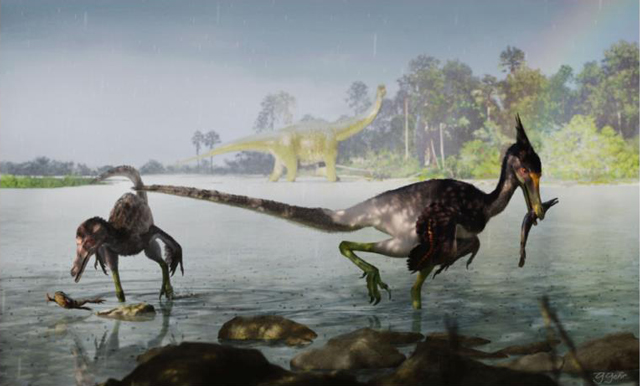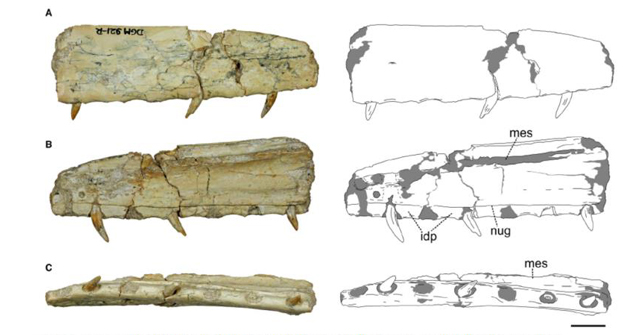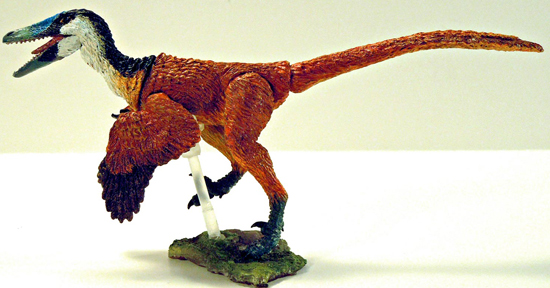Scientists have named a new species of dromaeosaurid from fragmentary jawbones found in Upper Cretaceous deposits in the Brazilian state of Minas Gerais (south-eastern Brazil). Named Ypupiara lopai, this is the first dromaeosaurid described from fossils found in Maastrichtian-aged deposits in Brazil. Y. lopai has been classified as a member of the dromaeosaurid subfamily the Unenlagiinae, possibly a sister taxon to Austroraptor (A. cabazai), which is known from the Late Cretaceous of Argentina.

Fragmentary Bones from the Jaws
A fragment of upper jaw and a piece of bone representing the back portion of the lower jaw (dentary), were found in close association and are believed to have come from a single animal. The fossils originate from the Marília Formation (Maastrichtian faunal stage).

The researchers, writing in “Papers in Palaeontology”, conclude that these fossils represent the first evidence of unenlagiines from the Marília Formation (Bauru Group, Brazil) and the second confirmed evidence of this type of dromaeosaur in Brazil. Previously, a single dorsal vertebra from the geologically younger Adamantina Formation (Bauru Group) had been assigned to the Unenlagiinae subfamily. Numerous isolated teeth had hinted at the presence of dromaeosaurs including potential unenlagiines in the Late Cretaceous of Brazil, but Ypupiara is the first to be named and scientifically described.
Outlining the Unenlagiinae
The Dromaeosauridae consists of several subfamilies although the taxonomy of this geographically and temporally widespread family of theropod dinosaurs is subject to almost constant revision as more fossil discoveries are made around the world. The Unenlagiinae comprises several genera of small to medium-sized theropods and for the time-being they are confined to the southern portion of the Gondwana landmass (Antarctica and South America). Their geographical distribution may change as fossil specimens from Madagascar, Europe, Australia and North America have been putatively assigned to the Unenlagiinae.
The biggest member of this subfamily described to date is Austroraptor, which at five-metres long was much larger than Ypupiara. To read Everything Dinosaur’s article from 2008 about the discovery of Austroraptor: Introducing Austroraptor – Fearsome Predator of the Late Cretaceous.
Models of this kind of dromaeosaur are few and far between, but within the Beasts of the Mesozoic “Raptor” series, the Wetlands Accessory Pack features a replica of Buitreraptor, an unenlagiine from western Argentina known from deposits some 30 million years older than those associated with Ypupiara lopai.

The picture above shows an articulated dinosaur figure from the Beasts of the Mesozoic model series.
To view this range of articulated prehistoric animals: Beasts of the Mesozoic Models and Figures.
A Fish-eating Dromaeosaurid
Analysis of the three teeth located in the upper jaw (shape and spacing along the jaw), suggests that Ypupiara was a piscivore (fish-eating). The strata associated with the fossil find, indicates that Ypupiara inhabited an alluvial floodplain with sediments extensively reworked by a braided river system. The genus name comes from the local Tupian dialect and refers to a mythical aquatic creature, a reference to the high probability that this little dinosaur lived near water. The species name honours Alberto Lopa, for his role in helping to map the geology of the state of Minas Gerais and in recognition of his discovery of the fragmentary bones that led to the erection of this new dinosaur genus.
Lost to Science
Sadly, the original fossils are no longer available to study. The fossil material was on loan to the Museu Nacional-Universidade Federal do Rio de Janeiro when fire destroyed the main building of the museum in September 2018, the fossils were not recovered and are considered to have been lost.
To read Everything Dinosaur’s blog post about the fire: The Devastating Fire at Brazil’s National Museum.
The scientific paper: “A New Unenlagiine (Theropoda, Dromaeosauridae) from the Upper Cretaceous of Brazil” by Arthur S. Brum, Rodrigo V. Pĕgas, Kamila L. Bandeira, Lucy G. Souza, Diogenes A. Campos and Alexander W. A. Kellner published in Papers in Palaeontology.
Visit Everything Dinosaur’s website: Everything Dinosaur.






Leave A Comment